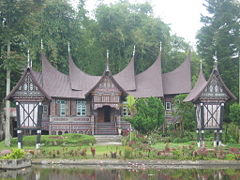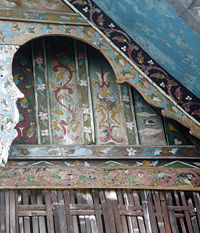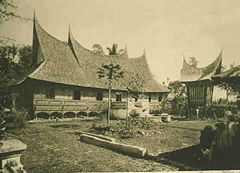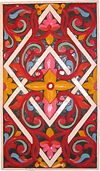Rumah Gadang
Rumah gadang (Minangkabau language: "Big house") are the traditional homes (Indonesian: Rumah adat) of the Minangkabau (also known as Minang or Padang), an ethnic group indigenous to the highlands of West Sumatra, in Indonesia. The architecture, construction, internal and external decoration, and the functions of the house reflect the culture and values of the Minangkabau. A rumah gadang serves as a residence and as a hall for family meetings and ceremonial activities. The Minangkabau society is matrilineal, and the rumah gadang is owned by the women of the family who lives there—ownership is passed from mother to daughter.
The houses have a dramatic curved roof structure with multi-tiered, upswept gables. Shuttered windows are built into walls incised with profuse painted floral carvings. Every aspect of the house has a symbolic significance related to Minangkabau adat (customary belief and law). The upward-curved finials (gonjong) on the peaks of the roof, said to represent buffalo horns, symbolize reaching to Heaven. The walls on the front and back elevations (dindiang tapi), traditionally made of plaited strips of bamboo, symbolize the strength and utility of the community which is formed when individual become part of the whole instead of standing alone. The arrangement of rooms in the house is seen as a reflection of a woman's life pattern, forming a journey from the central post to the public area (anjuang), then the bedrooms (biliak), and lastly to the kitchen. The term rumah gadang usually refers to larger communal homes, but smaller single residences share many of its architectural elements.[1]
Background
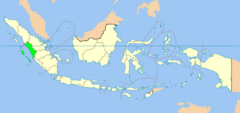
Sumatra is the sixth largest island in the world and since the time of Marco Polo has been referred to as the "island of gold." Including its tea, pepper and rubber plantations, and oil, tin and other minerals, it has more resources than any other island of Indonesia.[1] Lying on the equator, Sumatra has a monsoonal climate and although more rain falls between October and May, there is no extended rainless dry season. Despite large-scale deforestation, Sumatra still has millions of acres of unexploited rain forests which provide building materials. The great hardwood trees required for large scale construction are now, however, in strictly limited supply.[1]
Sumatra is home to one of the most diverse range of peoples in the South East Asian archipelago[1] and this diversity is reflected in a range of often dramatic traditional homes known as rumah adat. The most common forms of housing have traditionally been raised on piles, built of wood and locally gathered materials, with steeply pitched roofs. In addition to the Minangkabau's rumah gadang, the Batak of the Lake Toba region build the boat-shaped jabu with dominating carved gables and dramatic over-sized roofs, and the people of Nias build the fortified omo sebua houses on massive ironwood pillars with towering roof structures.
The Minangkabau are indigenous to the highlands of central Sumatra. Their culture is matrilineal, with property and land being passed down from mother to daughter, while religious and political affairs are the province of men. The Minangkabau are strongly Islamic, but also follow their own ethnic traditions, or adat (customary law). Minangkabau adat was derived from animistic and Hindu beliefs before the arrival of Islam, and remnants of animistic beliefs still exist even among some practicing Muslims. Women are customarily the property owners; husbands are only tolerated in the house at certain times and under special conditions, and must return to their sisters' house to sleep.[1] Complementing this practice is the custom of merantau whereby many of the men travel far from home for work, returning only periodically to their village of origin. Money earned on these trips is remitted for the building of contemporary rumah adapt.[1]
The term rumah gadang usually refers to larger communal homes, but smaller single residences share many of its architectural elements.[1]
It is not clear when the rumah gadang was first built; it is said to have originated in Pariangan, Batusangkar, the site of an early Minangkabau village. Pagarruyung Palace (in Batusangkar) dates to the Pagarruyung kingdom in the thirteenth century. The current structure was rebuilt in 1976.[2]
Form
A communal rumah gadang is a long house, rectangular in plan, with multiple gables and upsweeping ridges, forming buffalo horn-like ends. They normally have three-tiered projections, each with varying floor levels. They are broad and set on wooden piles that can reach as high as 3 meters (10 feet) off the ground; sometimes with a verandah running along the front face of the house which is used as a reception and dining area, and as a sleeping place for guests. Unlike the Toba Batak homes, where the roof essentially creates the living space, the Minangkabau roof rests on conventional walls. Cooking and storage areas are often in separate buildings.
The house is largely constructed of wood; an exception being the being the rear longitudinal wall which is a plain lattice woven in a chequered pattern from split bamboo. The roof is of a truss and cross-beam construction, and is typically covered with thatch from the fiber of the sugar palm (ijuk), which is the toughest thatch material available and is said to last a hundred years.[1] The thatch is laid in bundles which can be easily fitted to the curved, multi-gabled roof. Contemporary homes are more frequently using corrugated iron in place of thatch.
Roof finials are formed at the peaks from thatch bound by decorative metal bindings and drawn into points said to resemble buffalo horns—an allusion to a legend concerning a battle between two water buffaloes from which the "Minangkabau" name is thought to have been derived. The roof peaks themselves are built up out of many small battens and rafters.
The women who share the house have sleeping quarters in alcoves, traditionally odd in number, set in a row against the rear wall, and curtained off by the vast interior space of the main living area. Traditionally, large communal rumah gadang are surrounded by smaller homes built for married sisters and daughters of the parent family. It is the responsibility of the women's maternal uncle to ensure that each marriageable woman in the family has a room of her own, and this is accomplished either by building a new house or, more commonly, by adding annexes to the original one. It is said that the number of married daughters in a home can be known by counting its horn-like extensions; as they are not always added symmetrically, rumah gadang can sometimes look unbalanced.Cite error: Closing </ref> missing for <ref> tag
A number of rice barns (rangkiang) typically accompany a rumah gadang, with each having a different name and function. The rangkiang sitinjau lauik contains rice for guests and visitors and for the family on special occasions such as adat ceremonies. The rangkiang sitangka lapa contains rice for donation to poor villagers and for times of famine in the village. The rangkiang sibayau-bayau contains rice for the daily needs of the family.
Ornamentation
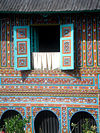
The Minangkabau traditionally embellish the wooden walls, pillars, and ceilings of the rumah gadang with bas-relief carved wooden motifs that reflect and symbolize their adat. The motifs consists of profuse floral designs based on a simple underlying geometric structure, and are similar to those of the Minangkabau woven songket textiles, with colors thought to have been derived from Chinese brocades.Cite error: Closing </ref> missing for <ref> tag
Use
Rumah gadang were traditionally inhabited by a single family group of three or four generations descended from one ancestor. Each of the Minangkabau identifies completely with his or her own rumah gadang.[3] Rumah gadang, in addition to serving as family residences, were used to hold family or tribal councils, weddings and adat ceremonies, and meetings to choose a successor when a tribal leader died.
Today rumah gadang are rarely occupied as people prefer to live in modern houses. Rumah gadang can still be found in West Sumatra, and efforts are being made to preserve the old buildings.[4]
See also
- Indonesia
- Minangkabau (an ethnic group in Indonesia)
Notes
- ↑ 1.0 1.1 1.2 1.3 1.4 1.5 1.6 1.7 1.8 Barry Dawson and John Gillow, The Traditional Architecture of Indonesia (London: Thames and Hudson, 1994, ISBN 0-500-34132X).
- ↑ Indonesia-tourism.com, Rumah Gadang is a Traditional House of the Minang Kabau people, Irwan, M.Pd—Language Counseling Service (UPB). Retrieved November 19, 2008.
- ↑ Artasia.com Traditional Houses. Retrieved November 19, 2008.
- ↑ Ibid.
ReferencesISBN links support NWE through referral fees
- Dawson, B., and J. Gillow. The Traditional Architecture of Indonesia. London: Thames and Hudson Ltd. 1994. ISBN 0-500-34132-X.
- Kartikawening, Dyah. Public Space Dynamic in Minangkabau Rural Area Indonesia. American Planning Association National Planning Conference Proceedings. Retrieved November 20, 2008.
- Nas, Peter J.M., and Martin A. van Bakel. “Small town symbolism: The meaning of the built environment in Bukittinggi and Payakumbuh.” Urban symbolism and rituals. Retrieved November 20, 2008.
- Ng, Cecilia. “Raising the House Post and Feeding the Husband Givers: The Spatial Categories of Social Reproduction Among the Minangkabau.” Inside Austronesian Houses: Perspectives on Domestic Designs for Living. Retrieved November 20, 2008.
- Summerfield, Anne, and J. Summerfield. Walk in Splendor: Ceremonial Dress and the Minangkabau. UCLA, 1999. ISBN 0-930741-73-0.
- Vellinga, Marcel. “A family affair: the construction of vernacular Minangkabau houses.” Indonesia and the Malay World. Routledge
- Vellinga, Marcel. Constituting Unity And Difference: Vernacular Architecture In A Minangkabau Village. Koninklijk Instituut Voor de Tropen, 2005. ISBN 9-067182-30-3.
External Links
All links retrieved November 19, 2008.
- Artasia.com Traditional Houses
- Indonesia-tourism.com Rumah Gadang is a Traditional House of the Minang Kabau people Irwan, M.Pd - Language Counseling Service (UPB), Source : www.kangguru.org
Credits
New World Encyclopedia writers and editors rewrote and completed the Wikipedia article in accordance with New World Encyclopedia standards. This article abides by terms of the Creative Commons CC-by-sa 3.0 License (CC-by-sa), which may be used and disseminated with proper attribution. Credit is due under the terms of this license that can reference both the New World Encyclopedia contributors and the selfless volunteer contributors of the Wikimedia Foundation. To cite this article click here for a list of acceptable citing formats.The history of earlier contributions by wikipedians is accessible to researchers here:
The history of this article since it was imported to New World Encyclopedia:
Note: Some restrictions may apply to use of individual images which are separately licensed.
